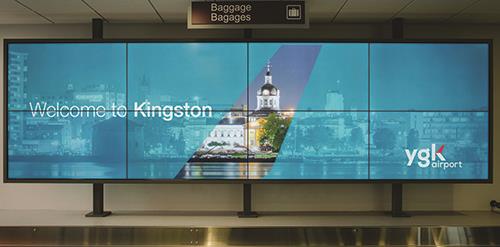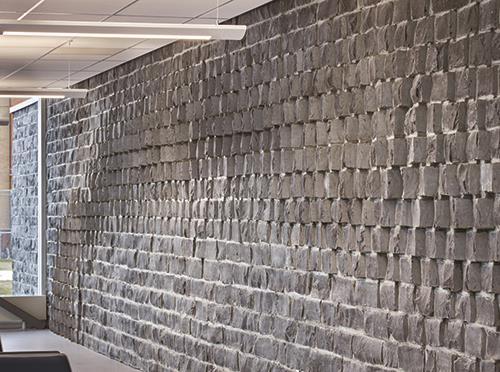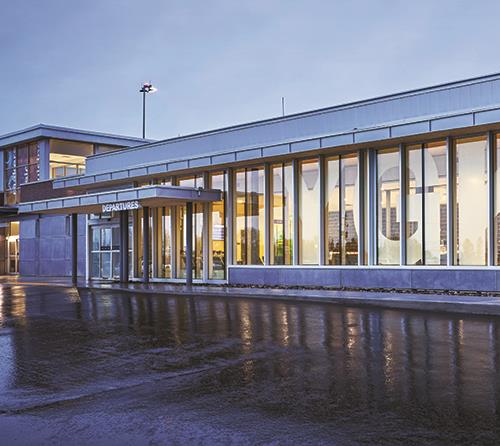Just as home rennovations turn life upside down for families, infrastructure projects complicate life for airport operators. Kingston’s Norman Rogers Airport (YGK) in eastern Ontario, Canada, worked dilligently to keep operations running smoothly for customers while completing $16 million of improvements spanning landside and airside areas alike.
Just as home rennovations turn life upside down for families, infrastructure projects complicate life for airport operators. Kingston’s Norman Rogers Airport (YGK) in eastern Ontario, Canada, worked dilligently to keep operations running smoothly for customers while completing $16 million of improvements spanning landside and airside areas alike.
Ultimately, the work scope included a 6,000-square-foot terminal expansion with renovations and extensions that added 1,000 feet to one of the airport’s two asphalt runways. Construction started in April 2018, and the expanded runway was operational in December 2018. The grand reopening of the terminal building occurred in July 2019.
Aron Winterstein, acting manager at YGK, explains that the overriding goal was to create a beautiful gateway to the picturesque place on the shores of Lake Ontario known as Limestone City.
|
facts&figures Project: Expansion & Renovation Location: Norman Rogers Airport – Kingston, ON Owner: City of Kingston 2018 Passenger Volume: 80,000 Primary Projects: Extending runway; expanding & renovating terminal Total Cost: $16.1 million Timeline: Construction began April 2018; runway operational Dec. 2018; terminal grand reopening July 2019 Key Runway Components: 1,000-foot extension; new LED lighting; designed to meet Transport Canada TP312-5th edition Key Terminal Components: 6,000 sq. ft. of new space; limestone wall art installation; elevator to 2nd floor; new departures lounge Design/Builder: H.R. Doornekamp Construction Ltd. Architect: HDR Architecture Associates Inc. Civil, Structural, Mechanical & Electrical Engineer: EXP Engineers Airfield Lighting: Approach Navigation Systems Inc. Paving: Coco Paving Required Fill for Runway Extensions: 200,000 metric tonnes |
“For this project, we had a significant focus on customer experience,” says Winterstein. “We’re making sure we have an efficient, modern facility that we can continue to use long into the future.”
Taking Off
The project focused on three main objectives: extending the primary runway, expanding the terminal building and enhancing the customer experience at YGK.
First, Runway 01-19 was extended from 5,000 to 6,000 feet. Project designers added 300 feet to the south end, and another 700 feet to the north. This work required approximately 200,000 metric tonnes of new granular material.
Winterstein explains that airport and city officials considered the extra runway length an essential component to help YGK stay connected to the world now and in the future. With a 6,000-foot runway, the airport is not only safer for small aircraft, it now has the capacity to bring in larger aircraft such as the Dash 8, Q400 and Boeing 737.
The construction team was tasked with building the runway extensions to meet Transport Canada’s new TP312-5th edition Aerodrome Standards and Recommended Practices. According to Jeff Simpson, project manager/estimator for design/builder H.R. Doornekamp Construction, several changes were incorporated between the fourth and fifth editions of the standard. Some of those changes include the types of paint markings required for short lines such as taxiway lines and new standards for runway signs. But the integrated design/build team, the city’s team and agencies including Transport Canada and NAV Canada worked together to make sure that the airfield project at YGK achieved compliance.
In addition to building the runway extensions, crews upgraded the instrument landing system with new technology and installed LED lighting.
Material Matters
Handling the massive amount of fill that was required for the north side of the runway extension proved to be a key challenge for the project team. Trucking in 200,000 metric tonnes of fill would have presented logistical and envrionmental challenges. So the team devised another way.
Instead of relying on trucks, H.R. Doornekamp transported the fill on barges that run along the shores of Lake Ontario. The fill came from the company’s quarry in Picton, which is about 37 miles west of the airport. Winterstein notes that this strategy was not only more efficient, but it also reduced the project’s greenhouse gas emissions by keeping a parade of trucks off the road.
Construction of the runway extensions was extended for about one year when the poor condition of existing power cabling for lighting and communications was detected early in the design and construction phases.
The city elected to incorporate additional upgrades to the primary electrical cabling for runway lighting, which involved the complete replacement of existing aging infrastructure that was previously identified to remain. In addition, a wireless system replaced some of the former communications lines.

Improving Facilities & Service
The terminal building, which was previously about 11,000 square feet, now stands at 17,000 square feet—an increase of approximately 54%.
Beyond expanding the physical size of the building, the city and airport focused on giving passengers a better overall experience at YGK. Jason-Emery Groen, vice president and design director of HDR Architecture Associates Inc., notes that the terminal expansion was designed not just for functionality, but also to give arriving passengers a sense of place.

“This is not just a building designed to get as many passengers to move through it as possible,” Groen explains. “We were thinking about how people will arrive in the city and what their first impression will be.”
Kingston has long been known as a place where history and innovation come together, he adds. To communicate Kingston’s notoriety as the “Limestone City,” Groen and his team designed an artistic wall installation that prominently features limestone. The wall was created using state-of-the-art parametric digital technology, and was designed to convey Bernoulli’s principle by coursing and positioning each piece of stone to demonstrate how the shape of an aircraft’s wings help it take flight.
Typically, when architects design such features, they leave it to the masons to install them according to drawings. However, in this case, Groen and his team arrived onsite daily to help lay the stones with the mason to ensure it would be assembled properly.

Planning Ahead
After the city issued the original concept design to design-builders potentially competing for the job, HDR and and H.R. Doornekamp determined that the construction sequencing could put work crews in the way of tarmac operations, which would prove complicated and expensive. That inspired a plan to expand the terminal laterally—extending west to east—and thus avoid protruding onto the tarmac. This way, Groen explains, if the city of Kingston wants to expand the terminal again, it can avoid dismantling the tarmac, which provides value well into the future.
“The city told us this is one of the reasons we won the project,” he notes.
As the acting airport manager, Winterstein acknowledges this was an important part of HDR’s bid. However, there is some dispute in his mind over who the real winner is at the end of the day. “This beautiful facility is a resource for our residents, and our region,” he remarks. “With the renovations behind us and new infrastructure in place, we are looking forward. YGK Airport is ready for takeoff.”



